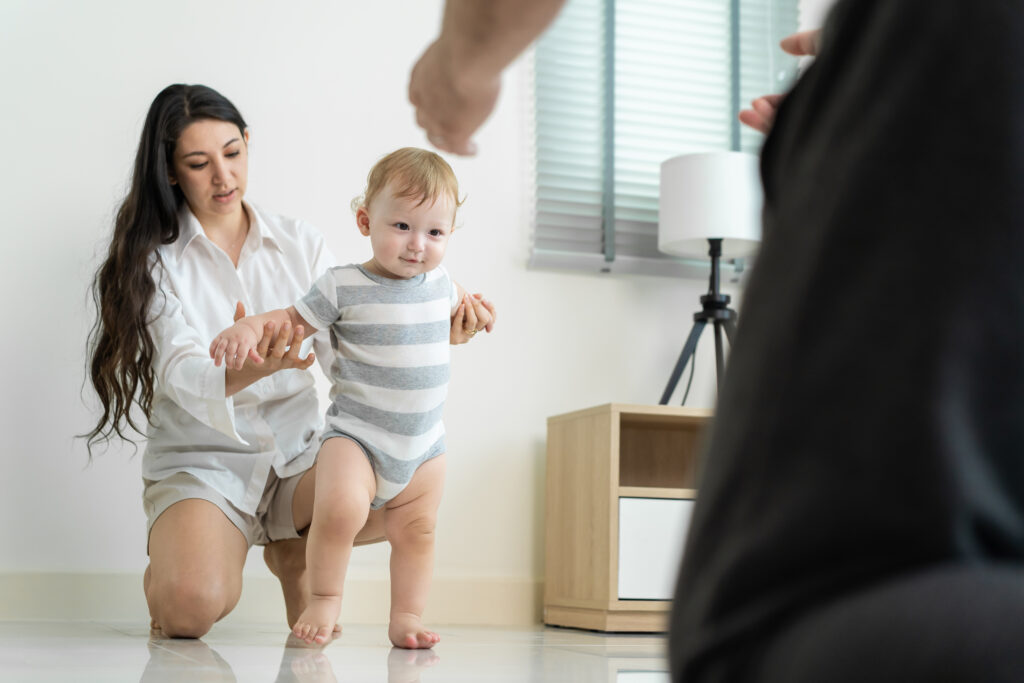The period of time between a baby’s first coo and first steps is enchanting and transforming, full of wonder, joy, and expectation. One of the most exciting developmental milestones in early childhood is witnessing your baby take those first, hesitant steps, which mark the beginning of their independence and a new phase of exploration and development. But learning to walk is a difficult process that calls for perseverance, support, and a thorough comprehension of a baby’s developmental stages.
This all-inclusive book is meant to help you and your infant throughout this incredible journey. We will guide you through every crucial phase of your child’s development as they learn to walk, providing helpful advice, in-depth methods, and priceless insights to make sure your child reaches this milestone securely and self-assuredly. We’ll cover every facet of teaching your baby to walk, from providing a safe, risk-free environment to developing the required motor skills and coordination. This guide is intended to provide you with the information and techniques you need to make this developmental stage as easy and joyful as possible, whether you are negotiating the difficulties of striking a balance between help and independence or looking for guidance on how to solve frequent problems. Savor every tiny step your baby takes as they learn to navigate the world on two feet by embracing this unique moment.
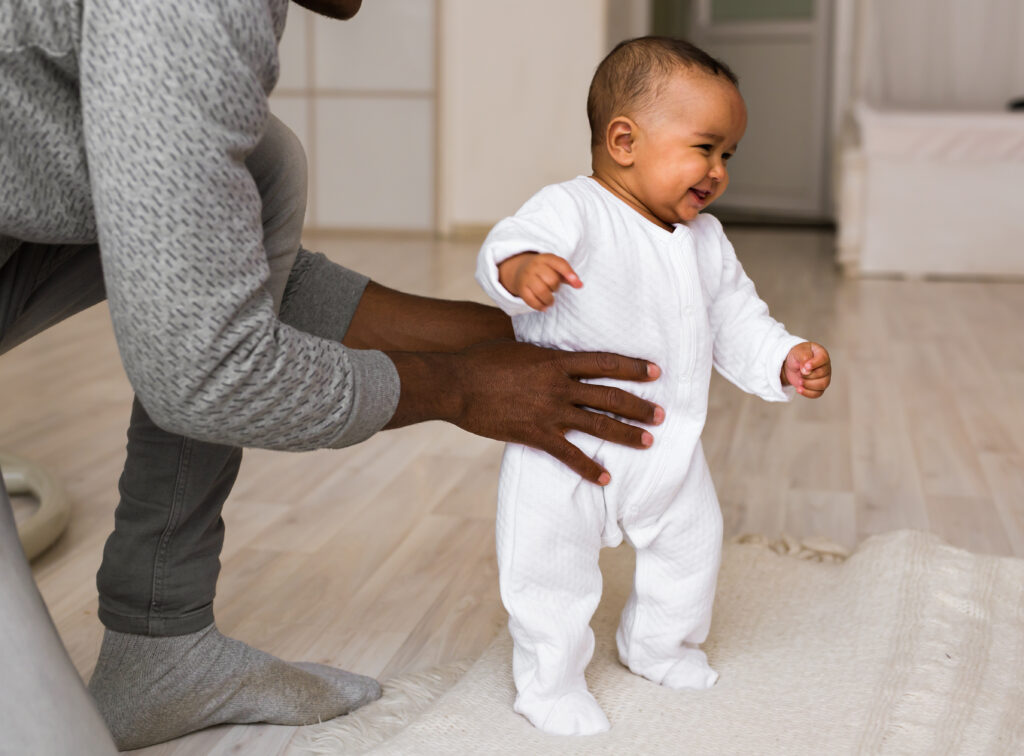
Recognizing the Walking Stages
Before diving into the teaching process, it’s essential to understand the developmental stages that lead to walking:
Being seated (Four to Seven Months)
Babies acquire the muscles necessary for unassisted sitting during this stage. This is a fundamental achievement that facilitates more advanced mobility stages. Babies will initially sit with assistance, frequently being held by caretakers or propped up with pillows. They eventually learn how to balance on their own as they practice, using their hands for support when necessary. Many babies can sit for extended periods of time without assistance by the end of this stage, which frees up their hands for play and exploration. The benefits of sitting include strengthening the core muscles, which are necessary for more advanced levels of movement. Furthermore, sitting up straight helps newborns develop cognitively and improves their social relationships by giving them a fresh perspective on the ability to engage with their surroundings.
Crawling (Seven to Ten Months)
An important developmental milestone for a baby is learning to crawl. It improves limb coordination in addition to strengthening upper body strength, particularly in the arms and shoulders. To begin with, babies learn about balance by swaying back and forth on their hands and knees. They eventually learn how to move themselves forward by alternating between using their hands and knees. There are several ways to crawl: the classic hands-and-knees crawl, the commando crawl (on the belly), and scooting on the ground. The development of the motor skills and coordination required for walking depends on this stage. Additionally, crawling encourages cross-lateral motions, or the movement of opposing limbs together, which is important for brain development and the formation of neural networks that will eventually support writing, reading, and walking.
Grasping for Balance (Eight to Ten Months)
During this phase, infants start to raise themselves to a standing position with the assistance of furniture or other sturdy items. This phase is essential for increasing leg strength and enhancing balance. With experience, they will be able to stand for longer amounts of time and more steadily, however at first they might only be able to stand for a few seconds before falling back down. Babies learn to pull themselves up to stand by practicing leg weight bearing, which is a necessary step before learning to walk. Additionally, during this time toddlers learn how to shift their weight—a skill that is essential for walking. By providing safe, solid items for newborns to pull up on, including activity centers made just for this purpose or furniture with rounded edges, parents and other caregivers can encourage this stage of development.
Cruises (Nine to Twelve months)
Babies that are cruising move along furniture while clinging to surfaces for support. As infants learn to shift their weight from one leg to the other and take baby steps sideways, this stage helps them improve their balance and coordination. Babies on the cruise line frequently experiment with releasing one hand, which improves their balance and gets them ready to stand on their own. Babies also begin to improve their depth perception and spatial awareness at this time. They gain valuable experience judging distances and navigating around obstacles while cruising, which is crucial for safe walking. By providing a secure setting with lots of opportunities for practice, such as arranging furniture so that newborns can easily go from one piece to another, parents and other caregivers can encourage cruising in their babies.
Being able to stand alone (Ten to Twelve Months)
Babies start to stand unassisted as they get more self-assured and balanced. The baby’s ability to stand on their own is a noteworthy achievement since it shows that their muscles and coordination have matured to the point where they can balance without support. With repetition, babies will stand for longer amounts of time and even try to crouch and stand back up, which further improves their leg muscles. At first, they might only stand for a few seconds before sitting back down. This phase is essential for gaining the self-assurance and balance required for walking. A crucial step towards taking their first steps is for babies to learn to trust that they can stand on their own.
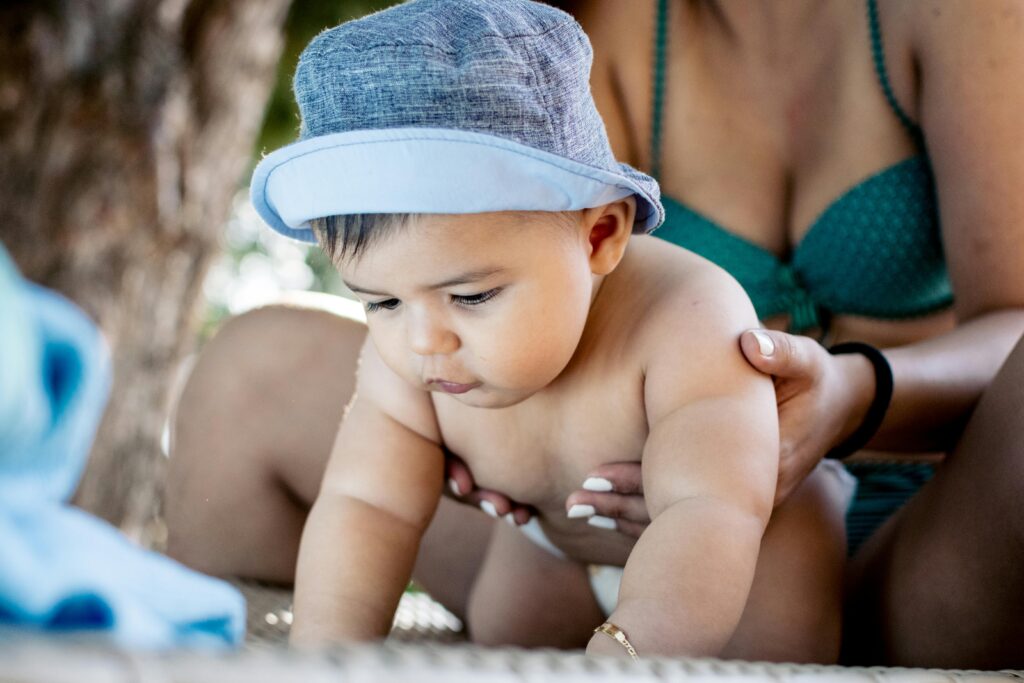
Initial Moves (Twelve to Fifteen Months)
For babies, taking their first independent steps is a huge accomplishment. Babies usually go from crawling to walking at this stage, which is full of trial and error as they gain confidence and motor skills. Babies frequently take a few tentative steps before falling down, and their first steps may be timid and unsteady. However, babies will begin to walk more steadily with encouragement and practice. This stage is the conclusion of all the earlier ones and the start of a brand-new independent and exploratory phase. Babies who walk more confidently begin to explore their surroundings more freely, which fosters the development of their cognitive abilities, spatial awareness, and physical fitness. This stage can be assisted by parents and other caregivers by creating a secure practice space, giving support, and acknowledging every little advancement.
On their own, walking (Twelve to Eighteen Months)
Babies have more control over their motions as they progress from their first steps to walking on their own. At this point, they have mastered coordination and balance, which allows them to walk unassisted. Their gait may be wide and erratic at first, but it will eventually become more assured and steady. Babies who can walk on their own are more free to explore their surroundings, which promotes independence and curiosity. They might also begin to walk backward, round corners, and stop and start on their own during this phase. By offering lots of practice opportunities and establishing a secure environment for exploration, parents and other caregivers can help this stage of development.
Jogging (Eighteen to Twenty-four Months)
Babies start experimenting with running once they have mastered walking. At this point, balance, coordination, and muscle strength have all significantly improved. Walking naturally leads to running, and while it may begin as a fast stroll or a shaky run, babies soon gain confidence and ability. For the development of cardiovascular health and general fitness, this stage is crucial. Running also improves coordination and gross motor abilities. In addition to creating open areas where people can run safely, parents and other caregivers can promote running by playing games that entail chasing after someone while they run.
Climbing (Eighteen to Twenty-four Months)
One important developmental milestone that frequently coincides with running is climbing. Babies begin to climb furniture, stairs, and playground apparatuses, which enhances their motor abilities, strength, and ability to solve problems. As newborns learn to grab, pull, and balance themselves, climbing tests their fine and gross motor skills. Additionally, this stage improves danger assessment and geographical awareness. This period can be supported by offering safe climbing options, including supervised play on playground equipment or climbing toys. Childproofing the house is also crucial to avert mishaps during this exciting stage.
Leaping (Twenty four to Thirty six)
Running and climbing are usually followed by the development of the complicated ability of jumping. It calls for a great deal of balance, coordination, and strength. Babies can initially only raise both feet off the ground at the same time, but with repetition, they can eventually learn to jump off low objects as well as forward and backward. Jumping is a great way to increase leg strength and enhance general coordination. It also supports cardiovascular health and bone density. Children can hone this talent by being encouraged to leap through games, obstacle courses, and structured play. By utilizing soft surfaces and making sure that play places are clear of potential risks, parents and other caregivers can establish safe spaces for jumping.

Establishing a Secure Environment
While teaching a baby to walk, safety must always come first. Here’s how to establish a secure setting:
Eliminate Risks: Make sure there are no possible risks in the area where your infant will be walking. Take out any little items, furniture with sharp edges, and anything that could choke a child. To stop people from falling and tripping, secure loose carpets. Use furniture corner protectors as well to reduce the chance of harm occurring in the event that your infant knocks into them.
Baby-proof the House: Make your house baby-proof by taking preventative actions. To stop falls, put in safety gates at the top and bottom of stairs. To avoid electrical mishaps, cover electrical outlets with outlet covers or safety plugs. Keep cleaning supplies, prescription drugs, and other potentially dangerous items locked in cupboards to keep them out of reach.
Non-slip Socks and Shoes: Make sure your infant is wearing the right shoes. Choose socks with non-slip grips on the soles if they’re wearing them to give them traction and stop them from slipping on flat surfaces. When it comes time to introduce shoes, choose for lightweight, flexible styles that promote natural foot motion. Steer clear of shoes with thick, stiff bottoms as they can impair coordination and balance.
Supervision: Keep a tight eye on your infant as they explore and learn to walk. Accidents can occur even in a safe setting, therefore it’s critical to have ongoing supervision so that someone can step in if needed. If your infant stumbles or loses their equilibrium, stay close enough to help them by holding their hand. You can guarantee their safety and provide support as they become more self-assured in their walking abilities by keeping a close check on them.
Soft Landing Zones: To prevent falls, designate soft landing zones all around the walking area. If your infant is likely to walk or play in certain locations, place thick rugs or foam play mats there. These cushioned surfaces lessen the chance of harm by absorbing some of the shock from falls. To give your child a secure place to practice walking without worrying about making a hard landing, you might also think about setting up a dedicated play area with padded flooring.
Promote Good Posture: Help your infant walk with good posture to reduce the chance of falls and accidents. Urge them to maintain a head up, shoulders back, and slightly outstretched arms for stability. If necessary, gently support their back; however, do not provide too much support as this could impair their normal range of motion. Encouraging your infant to walk with proper posture from an early age can help them develop strong core muscles and coordination, which can lessen the chance of accidents.
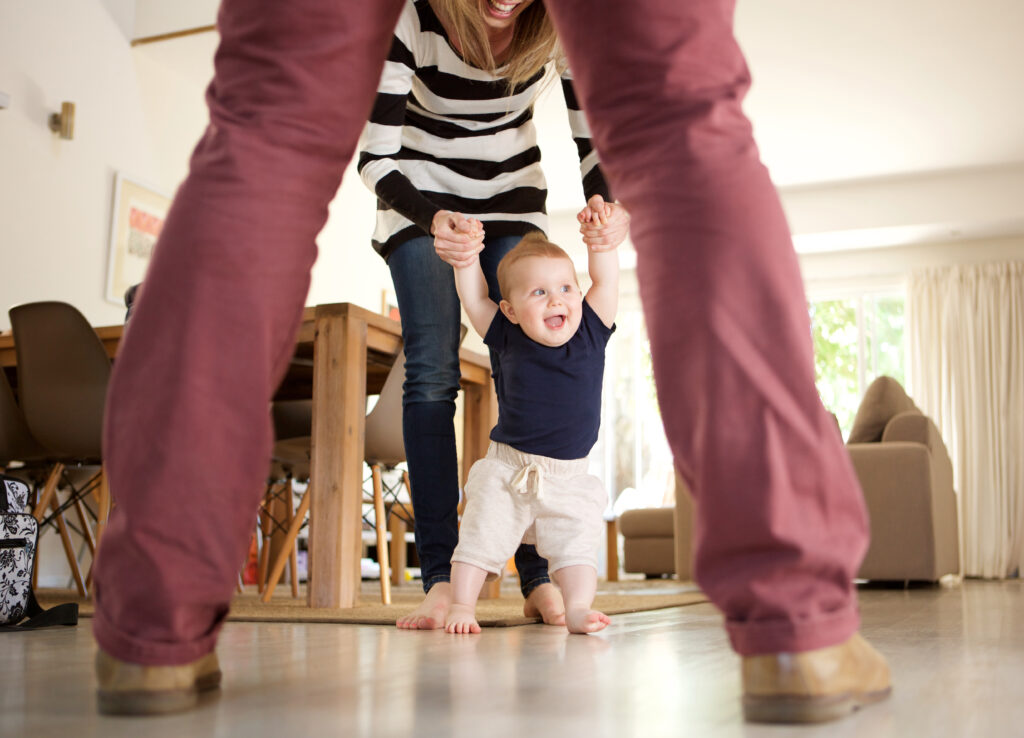
Increasing Muscle Mass and Sync
To walk, babies need to have strong muscles and good coordination. The following exercises will help you develop these abilities:
Stomach Time: Since stomach time helps newborns develop the muscles needed for lifting their heads, pushing up on their arms, and eventually crawling, it is crucial to encourage it from an early age. A baby’s neck, back, and arm muscles are used when they are on their stomach to raise their head and look around. Tummy time sessions can start off brief and often and then get longer as the infant gets more comfortable.
Sitting Play: Giving infants exercises that promote sitting upright aids in the development of their core stability and strength. Babies learn how to balance while seated by using toys that demand reaching and twisting activities. While they reach for and handle objects that are within their grasp, these activities also improve hand-eye coordination.
Crawling Games: Make crawling more enjoyable for babies by setting up an obstacle course with pillows and tunnels. A crucial developmental milestone that supports the growth of arm, leg, and core muscles is crawling. Babies that successfully navigate obstacles gain muscle strength, enhanced spatial awareness, and improved motor coordination.
Standing Support: By using furniture or your hands to support them when they stand, you can help newborns improve their leg strength and balance. Encouraging them to transfer their weight from one leg to the other helps them become more coordinated and stable. Their next milestone, which is learning to cruise and then walk, is facilitated by this exercise.
Cruising Practice: Babies are encouraged to move while clinging to furniture for support when toys are positioned slightly out of reach along a couch or low table. As babies learn to navigate their environment while standing and moving, cruising aids in the development of their balance and coordination. Additionally, it tones their leg muscles so they can walk independently.
Rolling Exercise: Help your infant get comfortable rolling from their back to their stomach and the other way around. Their ability to shift between positions is enhanced and their core muscles are strengthened by this exercise. To encourage them to roll and reach for objects, place colorful toys just out of reach. This will improve their motor skills and spatial awareness.
Investigative Texture Play: Give your infant a variety of textured objects to investigate, like plush toys, textured balls, and soft fabrics. In order to promote sensory development and the development of fine motor abilities, encourage children to touch, grasp, and manipulate these objects. In addition to teaching them how to connect with their surroundings in a variety of ways, exploring various textures helps them develop their hand-eye coordination and utilize their muscles.

Encouraging Independent Standing
Encourage your infant to stand on their own once they feel secure enough to cruise:
Small Distances: Encourage your infant to stand up and reach for a favorite object or toy that is placed a small distance away from them. You can encourage them to contract their muscles and work toward standing independently by offering them an incentive they will find enjoyable. As your infant gains confidence in their standing abilities, progressively raise the challenge from a reachable distance.
Helped Standing: Hold your infant’s hands when they stand to encourage their attempts. At first, give them just enough aid to help them balance, then progressively lessen your help as time goes on. Your infant will be encouraged to gain the strength and self-assurance necessary for standing independently by this gradual removal of support. To avoid any unintentional falls, make sure to hold onto anything firmly.
Balance Games: Play games with your infant to help them develop stability and balance. To help them retain their balance and change their weight, you could, for instance, grasp their hands and sway gently from side to side. Encourage them to squat and stand back up as well; this will help them develop stronger leg muscles and better balance. These engaging exercises help your infant gain the motor skills needed for independent standing while also making standing enjoyable.
Interactive Mirror Play: Have your baby stand and gaze at their reflection in a baby-safe mirror that is placed at eye level. Infants may be inspired to stand on their own to obtain a better perspective since they are frequently enthralled with their own reflections. Play interactive games with your baby, such as face-making, waving, or peek-a-boo in the mirror, to keep them interested and motivate them to stand for extended periods of time.
Include Dancing and Music: When you play lively music, get your infant to stand and move in time with the beat. In addition to encouraging physical exercise, dancing helps your infant learn how to use their muscles and maintain their balance when standing. Grasp their hands and sway in unison, inspiring them to follow your lead or take baby steps. Your infant can get more confident in their standing abilities and enjoy standing more while they are moving and listening to music.
Employ Assistive Furniture: Introduce toys or supportive furniture that promote standing. Give your infant a strong play gym or activity table, for instance, with handles or rails so they can grip onto it when standing. Your infant may practice standing independently with the stability and confidence our supporting structures provide. As they become stronger and more balanced, gradually lessen their dependency on help until they are able to stand on their own.
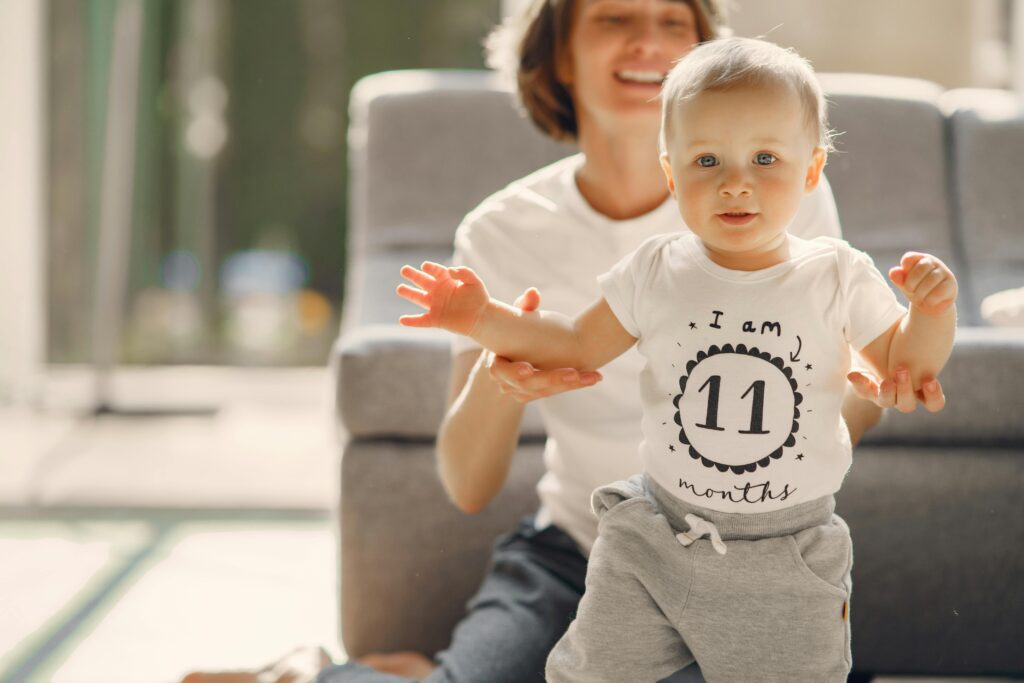
Motivating Infants to Walk for the First Time
An infant’s development significantly advances when they take their first steps. Here’s how to support this achievement:
Motivation: Provide your infant with toys, items, or even yourself as rewards for taking steps. Keep these tempting objects just out of your baby’s reach to entice them to approach. Your baby’s interest and urge to explore can be piqued by encouraging them to reach for objects, which may motivate them to take their first steps.
Supportive Holding: As your child begins to walk, gently direct them by holding their hands or providing support beneath their arms. As they gain confidence, gradually reduce the level of assistance, starting with just enough to make them feel secure. Give your infant the chance to learn how to walk while feeling secure and supported by providing a firm base of support.
Practice Time: Give your infant lots of chances each day to get practice walking. Practice sessions that are short and frequent are more productive than ones that are long and rare. Provide a nurturing atmosphere where your infant is at ease and inspired to experiment with their newfound ability. You can support their motor development and strengthen the brain connections involved in walking by having them practice on a regular basis.
Praise and encouragement: Congratulate your child on every effort, even if it doesn’t work out the first time. To increase their self-esteem and drive, shower them with compliments, smiles, and supportive words. Their efforts are rewarded, and walking becomes associated with joy and a sense of accomplishment. You can give your infant the confidence to reach this milestone by fostering an environment that is encouraging and helpful.
Use a Walking Harness: Give your infant access to a baby walker or a walking harness that supports their weight while enabling them to move about freely. As babies practice walking, these devices give them extra stability and confidence. Make sure your baby is securely and comfortably fastened in the harness or walker, and keep an eye on them at all times while they use it.
Mirror Walking: Promote your infant to walk toward their reflection by placing a huge mirror at eye level. This technique is known as “mirror walking.” Mirrors typically pique the interest of babies, who may be inspired to walk in order to investigate their reflection. This exercise improves your baby’s coordination and gait while also promoting walking and provide visual feedback.
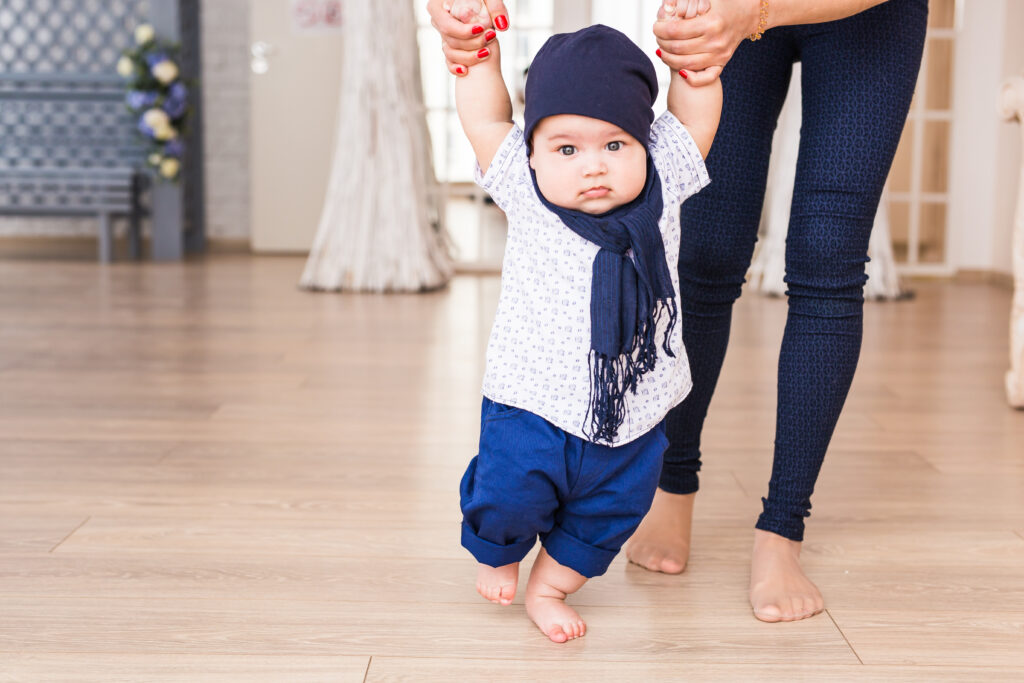
Troubleshooting Typical Problems
You could run into several difficulties when teaching a newborn to walk. Here’s how you respond to them:
Fear of Falling: If your child exhibits this fear, comfort them and stay by their side to offer support. As your infant gains confidence, gradually widen the space between you and them, but always be available to lend a helping hand. Establish a barrier-free, secure space for your infant to play in order to reduce the chance of falls.
Reluctance to Walk: Due to its familiarity and speed, some babies may choose to crawl rather than walk. Make walking enjoyable and fulfilling to promote it. To make the experience more delightful, walk towards your favorite item or play games that require you to walk. Give your child lots of love and support to encourage them to keep trying.
Balance Problems: To help your baby become more stable, practice standing and cruising if they have trouble with their balance. Use walking aids or push toys to encourage autonomous movement while providing stability and support. Include activities that test your baby’s coordination and balance, like playing games that require you to shift your weight from one foot to the other or walking on uneven surfaces. Your infant can overcome difficulties with balance and develop self-confidence in their walking abilities with regular practice and encouragement.
Provide Tactile Feedback: By providing textured mats or surfaces for your baby to walk on, you can provide tactile stimulation to their walking exercises. By providing sensory feedback, textured surfaces aid in the improvement of a baby’s sense of balance and coordination. To enhance their walking experience and stimulate their senses, encourage your baby to explore various textures with their feet while they walk.
Model Walking Behavior: Walk in front of your infant to provide them an example they can follow. Babies pick up skills by seeing and imitating the behaviors of others. To make it apparent and interesting for your infant, take a few steps in front of them while slightly exaggerating your actions. As they approach you, lead by example and give them encouragement and thanks for their efforts.
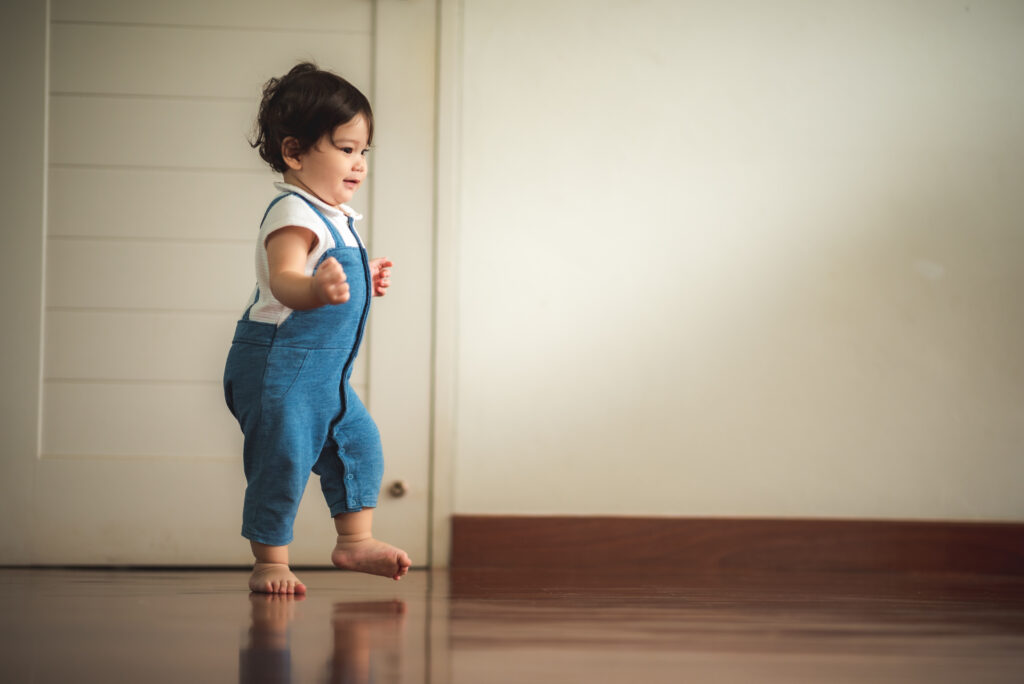
Including Walking in Everyday Tasks
Make walking practice a regular part of your baby’s day by including it into routines:
Outdoor Exploration: Let your infant roam outside and discover various landscapes. Take them on strolls across your area so they can experience walking on grass, gravel paths, and sidewalks. Take your baby on walks in the outdoors, where they can experience walking on uneven surfaces and receive a variety of sensory stimulation.
Interactive Playtime: Include walking drills in games during interactive playtime. Create mazes for your infant to explore by utilizing cushions, pillows, and tunnels. Urge them to climb over little barriers, crawl beneath obstacles, and stroll through the course. This improves motor abilities and spatial awareness in addition to encouraging walking.
Take Family Walks: Let your infant accompany older siblings or other family members on your family’s walks. Walking alongside family members makes the activity fun for your baby and strengthens family ties by offering social interaction and encouragement.
Indoor Playgrounds: Take a look at indoor playgrounds or kid-friendly play areas. These settings provide your infant with comfortable, safe spaces to practice walking and discover novel textures and shapes. When there are few outdoor options or bad weather, indoor playgrounds offer an engaging environment for walking practice.
Dance Parties: Set up dance parties at your house so that you and your infant can groove to music and move. Get your infant to follow you while you dance, using different motions such as bouncing, swaying, and stepping. Walking is encouraged by dancing, which also improves coordination and rhythmic abilities in a lighthearted way.

Tracking Development and Getting Expert Assistance
Every child develops at a different speed, so keep an eye on your baby’s development and exercise patience. Here are some pointers:
Document Progression: Track your baby’s walking development by keeping a log of their accomplishments and milestones. To monitor changes in balance, coordination, and self-assurance over time, record images or videos. Examining these documents can give you confidence and inspiration as you see your child grow.
Early Intervention Programs: You should think considering enrolling your kid in an early intervention program if you see noticeable delays in their walking development or have concerns about their development. These programs provide customized therapy and specialized support aimed at addressing developmental delays and advancing motor skills. Addressing issues and assisting infants in realizing their full potential can be greatly aided by early intervention.
Developmental Screening: To keep an eye on your child’s overall development, including the development of motor skills like walking, schedule routine developmental screenings with your pediatrician. These screens aid in the early detection of any potential delays or issues, enabling prompt intervention and assistance as required.
Parent Support Groups: Get in touch with other parents going through comparable struggles or developmental stages with their children by joining parent support groups or online forums. As you manage your baby’s development, talking with other parents about your experiences, suggestions, and resources can be a great way to get insightful knowledge and emotional support.
Consultation with Early Childhood Educators: To support your baby’s walking adventure, get individualized advice and solutions from early childhood educators or child development specialists. These experts can provide advice on activities that are appropriate for the child’s age, methods for improving walking abilities, and resources for taking care of any developmental issues.
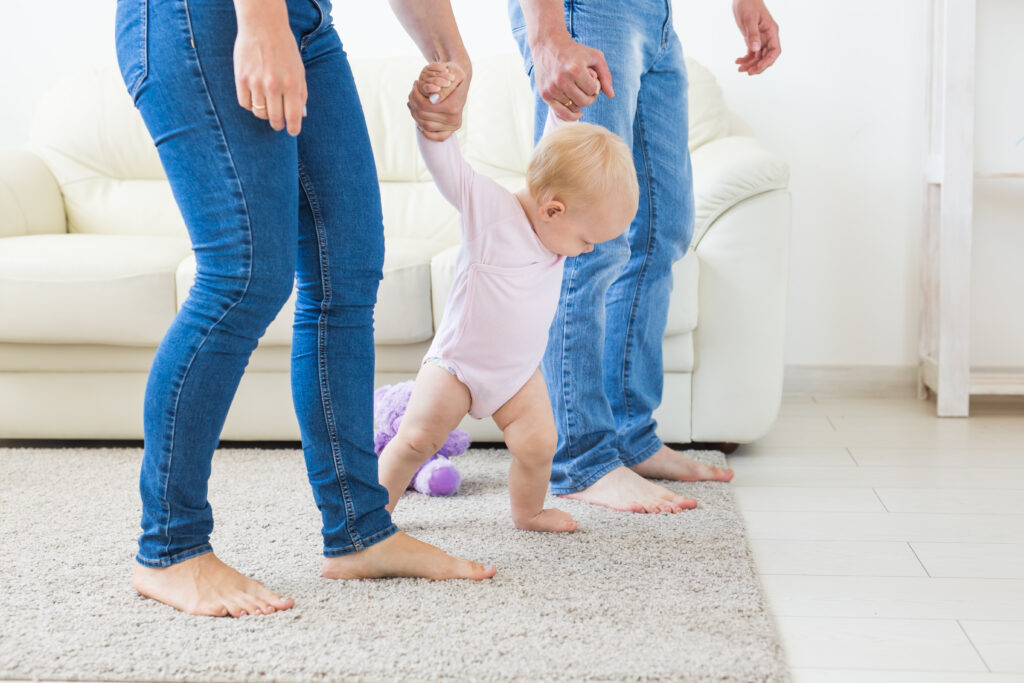
Tools and Toys to Aid Walking
A baby can learn to walk with the help of certain toys and tools:
Pull Toys: Give your infant some pull toys to grip and pull with them as they walk. As babies grow, these toys help them improve balance and coordination by offering extra support and stability. For safe and entertaining play, look for pull toys with robust construction and smoothly moving wheels.
Musical Walkers: Make an investment in musical walkers that have captivating sounds and interactive features. These walkers use music and lights to encourage babies to take their first steps. Select walkers that offer customizable speed settings to suit your infant’s walking style and promote steady advancement.
Walking Harness with grips: Invest in a walking harness that has grips so you can help and encourage your infant as they learn to walk. With the extra stability and control the handles provide, you can comfort and direct your baby’s movements while they investigate their environment.
Rolling Activity Centers: To promote walking and exploration, think about utilizing walkers with interactive features or rolling activity centers. With the help of these mobile play stations, your baby may practice walking on a stable surface while being entertained by engaging toys, buttons, and activities that foster cognitive and sensory development.
Obstacle Courses with Balance Beams: Set up narrow paths or balance beams in your home to create obstacle courses for your infant to maneuver through. As your baby walks around the raised surface, balancing beams test their coordination and balance while assisting in the development of core strength and stability. Begin with low lights and raise the challenge progressively as your child develops competence and confidence.

Promoting Social and Emotional Development
More than just a physical milestone, walking is essential for the social and emotional development of children.
Structured Playgroups: Enroll your infant in parent-child programs or structured playgroups that emphasize socialization and mobility. Through peer modeling and encouragement, these environments give your infant the chance to participate in developmentally appropriate activities with other kids, developing social bonds and boosting walking.
Family Outings: Take your infant along to social events and family outings so they can socialize with friends, family, and acquaintances. Participating in social gatherings introduces your infant to various social dynamics and stimulates their walking skills as they watch other people and try to get in on the fun.
Promote Empathy: Make use of strolling experiences to impart social skills and empathy. Urge your child to assist or stand by someone who might be having trouble walking or performing other tasks. Alongside physical milestones, social growth can be facilitated by cultivating kindness and empathy.
Animal Encounters: Encourage family pet playtime or visits to petting zoos to foster relationships with animals. Animals can be a baby’s source of emotional support and companionship, which helps develop empathy and nurturing traits. Under close supervision, encourage your infant to stroll and explore while connecting with friendly animals.
Community Events: Take your baby to events or get-togethers where they can interact with a variety of people and activities. In addition to providing opportunities for social connection and exposure to new experiences, festivals, fairs, and neighborhood picnics can help your baby learn to walk by allowing them to participate in group activities and observe others.
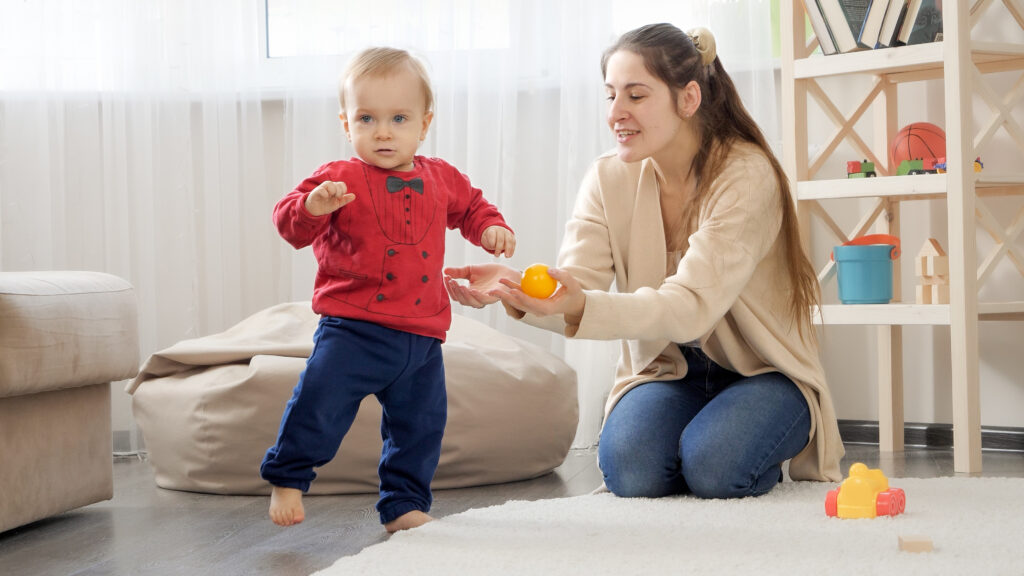
Balancing Independence and Support
It’s important to strike the correct balance between encouraging independence and providing support.
Incremental tasks: As your baby gains confidence in walking independently, present them with incremental tasks. Create scenarios where they must walk a little farther or negotiate a little more terrain, and offer them gentle help and encouragement as they take on each new task.
Honor Efforts: Regardless of the result, honor your baby’s endeavors and attempts at walking on their own. Recognize and support them for their bravery and tenacity, as this will boost their self-esteem and cultivate a positive outlook on education and discovery.
Model Independence: Set an example of independence for your child by acting independently and interacting with them. As infants gain mobility and confidence in walking, encourage them to emulate simple chores like feeding themselves, fetching stuff, or picking up toys. You may encourage your infant to accept their own independence by becoming an example of it.
Provide Safe Challenges: Provide your infant with safe challenges and hurdles to overcome on their own. For instance, place pillows or cushions in a trail for them to walk on, progressively extending the space between each one. These tasks help your infant develop balance and coordination while also fostering confidence and independence.
Give Verbal Encouragement: As your infant experiments with walking on their own, give them verbal encouragement and encouraging words. Use motivating statements like “You can do it!” or “You’re doing great!” to give them more self-assurance and drive. Your encouraging remarks increase their sense of self-worth and openness to taking on new tasks.

Starting the amazing process of teaching a newborn to walk involves a wide range of experiences, full of obstacles, thrills, and unmatched happiness. Fundamental to it all is the skill of establishing a secure yet supportive atmosphere that serves as a bedrock for their developing curiosity and discovery.
We work tirelessly to nurture the development of their fragile muscles so that they can progressively go from shaky crawls to sure strides. Every accomplishment, no matter how minor, is a monument to the limitless potential contained within each tiny frame, inspiring awe and pride in both parents and children.
We provide constant support as we traverse this amazing adventure, helping them step by step as they learn to stand and walk independently. We provide comfort and support during each slip and fall, helping them to develop the resiliency and willpower that will be useful in the adventures to come.
Patience becomes our most valuable ally during this life-changing journey as we accept the distinct rhythm of every baby’s individual growth. We celebrate both the child’s physical accomplishment and the strong link between parent and child, basking in the sheer joy of seeing those first hesitant steps.
Thus, let us treasure every moment as we go together through the incredible milestone of learning to walk, appreciating the process just as much as the end result, and relishing in the unending love and happiness that fills our hearts along the way.

